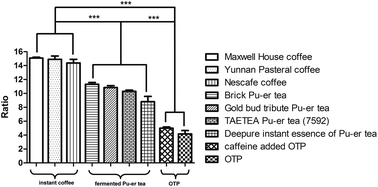Absorption of caffeine in fermented Pu-er tea is inhibited in mice†
Abstract
Caffeine is present in a number of dietary sources consumed worldwide. Although its pharmacokinetics has been intensively explored, little is known about complexed caffeine (C-CAF) in aqueous extraction of fermented Pu-er tea. The major components of C-CAF are oxidative tea polyphenols (OTP) and caffeine. Furthermore, the C-CAF can be precipitated in low pH solution. After administering the same amount of total caffeine and comparing the peak level of plasma caffeine with the coffee (contains 0.11 ± 0.01% C-CAF) group, the results showed that the caffeine/OTP (contains 66.67 ± 0.02% C-CAF) group and the instant Pu-er tea (contains 23.18 ± 0.02% C-CAF) group were 33.39% and 25.86% lower, respectively. The concentration of the metabolites of caffeine supports the idea that the absorption of the C-CAF was inhibited in mice. Congruent with this result, the amount of caffeine detected in mice excrement showed that more caffeine was eliminated in the caffeine/OTP group and the Pu-er tea group. The locomotor activity tests of mice demonstrated that the stimulating effect of caffeine in caffeine/OTP and Pu-er tea was weaker than in coffee. Our findings demonstrate that caffeine can be combined with OTP and the absorption of C-CAF is inhibited in mice, thus decreasing the irritation effect of caffeine. This may also be developed as a slow release formulation of caffeine.


 Please wait while we load your content...
Please wait while we load your content...